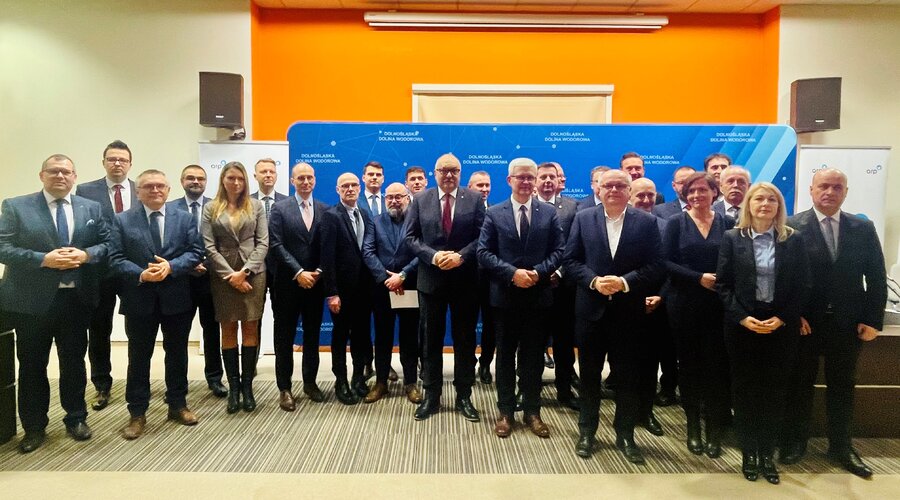Lower Silesian Hydrogen Valley kicked off
The Lower Silesian Hydrogen Valley was established on 25 February 2022 at the Conference Centre of Wroclaw Industrial Park on the initiative of the Agencja Rozwoju Przemysłu S.A. (Industry Development Agency JSC). The general business partner of the undertaking is KGHM Polska Miedź S.A. The event was attended by, among others, Ireneusz Zyska, Secretary of State, Government Plenipotentiary for Renewable Energy Sources, the persons associated with business, scientific and local government environments of both regions. ARP S.A. was represented by Vice-President Paweł Kolczyński, while KGHM Polska Miedź S.A. by Adam Bugajczuk, Vice-President of the Management Board for Development.
The mission of the Lower Silesian Hydrogen Valley is to support development of hydrogen economy, with particular focus on the Lower Silesian Voivodeships and the voivodeships adjoining this region.
The Lower Silesian Hydrogen Valley will make use of the scientific and research potential of the region to undertake among others innovative scientific, technological and industrial initiatives, as well as investment projects aiming at the establishment of joint value chains for a hydrogen economy. In addition, operations of the Lower Silesian Hydrogen Valley will contribute to the promotion of pro-environmental attitudes, in particular among the entrepreneurs and local communities.
“The role of hydrogen in the economy and in particular its potential for the decarbonisation of industry and of the heating and transport sectors continues to grow. Incorporation of hydrogen technologies into the state development policy, their improvement, building competencies and creating Polish products for export is a strategic challenge and requires a value chain-based approach. Shortening lines between supply and demand centres, integration of the sectors, finding business partners and optimisation of processes and costs – these are specific opportunities we will gain by establishing hydrogen valleys,” says Vice-Minister Ireneusz Zyska.
“Our sights are set on hydrogen and its use in our divisions or as a form of energy storage with great optimism and hope. We believe that using hydrogen as a fuel and reducer in our smelting furnaces may lead to zero-emission production of copper, silver and other metals in future. Before we achieve that, we need to construct the entire ecosystem and infrastructure supporting hydrogen use in the region. We therefore welcome the initiative and establishment of the Lower Silesian Hydrogen Valley,” adds Adam Bugajczuk, Vice-President of KGHM for Development.
The hydrogen valleys are tailored to the specific regional conditions and general objectives of the projects, thus there is no single versatile model. There are four key conditions that need to be fulfilled to speak of a hydrogen valley:
- large scale - a hydrogen valley consists of many smaller-scale projects that should go beyond the standard pilot and demonstration activities and be endowed with a substantial budget,
- well-developed value chain - a hydrogen valley should have common infrastructure related to production, storage and distribution, with the use of diversified means of transport,
- supply to more than one economic sector - hydrogen is used in many sectors of the economy (such as the chemical industry, steel industry, transport, the power sector, etc.),
- defined geographical range - the regional ecosystem should cover activities at the local and regional level (for example ports and their background facilities) but with a national or international range.
– The focus of ARP is on the development of methods and schemes for the "hydrogenation" of technological and production processes in the industry, especially in the context of their high energy intensity. We aim to involve a broad range of stakeholder communities of the Lower Silesian Hydrogen Valley into this initiative. We hope that such an association will act as a data and knowledge reservoir to provide support for the projects, for example at the time of establishment of a special-purpose vehicle for a specific undertaking. We see an opportunity to transfer hydrogen to and from Germany, especially in the context of the potential of our industrial parks in Lower Silesia: in Kobierzyce or Ząbkowice Śląskie,” says Cezariusz Lesisz, President of Agencja Rozwoju Przemysłu S.A.
There have been 36 hydrogen valleys currently operating throughout the world, including 20 in Europe. According to the "Polish Hydrogen Strategy until 2030" adopted by the Government in November 2021, Poland intends to build at least 5 hydrogen valleys. Following the 2020 EU Hydrogen Strategy, the Polish hydrogen valleys are to be included into the European Hydrogen Backbone. The Polish Hydrogen Valley Innovation Backbone will encompass the innovative industrial initiatives and large-scale multi-annual investment projects implemented within the specific geographical area.
The Agencja Rozwoju Przemysłu S.A. is involved in work aimed at the establishment of 4 hydrogen valleys in Poland. These include: the Subcarpathian Hydrogen Valley, the Lower Silesian Hydrogen Valley, the Mazovian Hydrogen Valley and the Silesian and Lesser Poland Hydrogen Valley. The Katowice Branch of ARP S.A. also administers the newly-deployed national hydrogen portal h2poland.eu with information on among others development of hydrogen valleys in the country.



